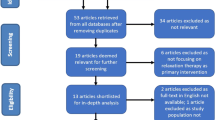Abstract
Tourette's syndrome is a lifelong disorder characterized by multiple motor and verbal tics. The present study examined relaxation training and desensitization training as a method of reducing the frequency and intensity of tics and the distress they caused in a young adult diagnosed with Tourette's syndrome. After a period of symptom monitoring the subject underwent 3 weeks of intensive training in relaxation skills and 5 weeks of desensitization training with situational cues previously identified as eliciting Tourette's symptoms. According to self-report monitoring, the experience of symptoms was decreased across 3 global dimensions: distress (48%), frequency (48%), and intensity (50%), and an hourly symptom count (50%). Collateral parental symptom report agreed with an observed decrease across distress (40%), frequency (41%), and intensity (40%). Inspection of data suggests that both components of stress management added to total treatment efficacy.
Similar content being viewed by others
References
American Psychiatric Association. (1987).Diagnostic and statistical manual of mental disorders (3rd ed., rev.) (DSM-III-R). Washington, DC: Author.
Azrin, N. H., Nunn, R. G., & Frantz, S. E. (1980). Habit reversal versus negative practice treatment of nervous ties.Behavior Therapy, 11 169–178.
Barabas, G., Matthews, W. S., & Ferrari, M. (1984) Disorders of arousal in Gilles de la Tourette's syndrome.Neurology, 34 815–817.
Benditsky, H. (1978). A psychosomatic approach to Gilles de la Tourette's syndrome.Dissertation Abstracts International, 39 969–970.
Blanchard, E. B., & Andrasik, F. (1985).Management of chronic headache: A psychological approach. Elmsford, NY: Pergamon Press.
Bliss, J. (1980). Sensory experiences of Gilles de la Tourette's syndrome.Archives of General Psychiatry, 37 1343–1347.
Brudny, J., Grynbaum, B. B., & Korein, J. (1974). Spasmodic torticollis: Tretment by feedback display of the EMG.Archives of Physical Medical and Rehabilitation, 55 403–408.
Brudny, J., Korein, J., Levidow, L., Grynsaum, B. B., Lieberman, A., & Erdman, L. W. (1974). Sensory feedback therapy as a modality of treatment in central nervous system disorders of voluntary movement.Neurology, 24 325–332.
Bullen, J. G., & Hemsley, D. R. (1983). Sensory experience as a trigger in Gilles de la Tourette's syndrome.Journal of Behavior Therapy and Experimental Psychiatry, 14 197–201.
Canavan, A. G. M., & Powell, G. E. (1981). The efficacy of several treatments of Gilles de la Tourette's syndrome as assessed in a single case.Behaviour Research and Therapy, 19 549–556.
Devinsky, O. (1983). Neuroanatomy of Gilles de la Tourette's syndrome: Possible midbrain involvement.Archives of Neurology, 40 505–513.
Glaze, D. G., Frost, J. D., & Jankovic, J. (1983). Sleep in Gilles de la Tourette's syndrome: Disorder of arousal.Neurology, 33 586, 592.
Price, R. A., Kidd, K. K., Cohen, D. J., Pauls, D. L., & Leckman, J. F. (1985). A twin study of Tourette's syndrome.Archives of General Psychiatry, 42 815–820.
Shapiro, A. K., Shapiro, E. S., Brunn, R. D., & Sweet, R. D. (1978).Gilles de la Tourette syndrome. New York: Raven Press.
Shapiro, E. S., & Shapiro, A. K. (1981). Tic disorders.Journal of the American Medical Association, 245 1583–1585.
Storms, L. (1985). Massed negative practice as a behavioral treatment for Gilles de la Tourette's syndrome.American Journal of Psychotherapy, 39(2), 277–281
Turpin, G., & Powell, G. E. (1984). Effects of massed practice and cue-controlled relaxation of tic frequency in Gilles de la Tourette's syndrome.Behaviour Research and Therapy, 22 165–178.
Wolpe, J. (1958).Psychotherapy by reciprocal inhibition. Stanford, CA: Stanford University Press.
Author information
Authors and Affiliations
Rights and permissions
About this article
Cite this article
Michultka, D.M., Blanchard, E.B. & Rosenblum, E.L. Stress management and Gilles de la Tourette's syndrome. Biofeedback and Self-Regulation 14, 115–123 (1989). https://doi.org/10.1007/BF00999049
Issue Date:
DOI: https://doi.org/10.1007/BF00999049




